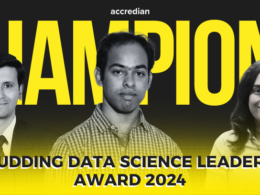As of today, IBM is offering a wide range of products and services which includes hardware architecture, financing and software solutions, and business and technology services. These products and services span across data analytics, storage, AI, IoT, and blockchain.
Since IBM is a data driven company, it understands the importance of data and data analytics at each layer of its organization in order to make better business decisions.
Thus, it is fair to say that Data Science is very important to IBM’s success.
Hence IBM requires an efficient team of Data Scientists in order to function. Data scientists at IBM are part of teams working on products and services such as IBM Infosphere, IBM Cloud Pak, IBM Watson Studio, IBM Db2, IBM SPSS, etc.
What IBM looks for in a Data Scientist?
Data Scientist roles at IBM require field-specialization, and so IBM hires only highly qualified individuals with at least 3 years of industry experience in data analysis, machine learning applications, and quantitative research.
How many interview rounds are there at IBM?
The interview rounds begin with an online coding test called ‘HireVue’. Following this is a phone screen interview with a recruiter or HR about the candidate’s resume, past experiences and relevant projects.
This is then followed by a technical screen that may consist of various coding questions ranging from basic Python, SQL, to medium-level Algo questions. The last stage is the onsite interview consisting of 3 interview rounds, which is slightly different from other tech companies.
IBM Data Scientist Interview Rounds
Check out the step-by-step process of IBM Data Scientist Interview below:
Round-1 Phone Screening
This is an ice breaking interview with a recruiter or a hiring manager. Questions in this interview basically revolve around your resume and background experience and how it aligns with the job role you are applying for.
You may be asked questions like- ‘Why do you feel you fit at IBM?’ or ‘What sets you apart from other candidates?’
Round-2 Technical Screening
This round of interview is set to be a lot more in depth than the previous round of interview. Questions like the following are asked on a regular basis:
- What challenges did you face?
- How did you choose the parameters?
- What techniques or methods did you use?
- How did you overcome those challenges?
There are many coding based questions that are asked as well, like:
- Given a number N. Find the minimum number of operations required to reach N starting from 0. You have 2 operations available:
-
- Double the number
- Add one to the number
- Given a boolean matrix of size RxC where each cell contains either 0 or 1, modify it such that if a matrix cell matrix[i][j] is 1 then all the cells in its ith row and jth column will become 1.
Round-3 On-Site Interview
The Data Scientist onsite interview consists of 3 interview rounds with a panel of interviews composed of senior data scientists, team managers and staff from Design, Statistics, Machine Learning, and Management.
Questions range from statistical concepts, machine learning concepts and methods, big data and frameworks, and situational-behavioral questions. Something like:
- How would you attempt to solve a data science problem?
- Describe prior projects/datasets that you worked with.
Other very common questions that are generally asked are:
- Why do you think your background is a good fit for IBM
- How do you deal with a missing value
- What is the matrix used to evaluate the predictive model?
- What is deep learning?
- What is a standard deviation?
- What is the difference between precision/specificity?
- How do you implement Fibonacci in python? Why is loop better than recursion?
20 questions to ace IBM Data Scientist interview
Here is a list of frequently asked questions at the IBM interview that have been categorised according to the difficulty level:
Easy
- What is the difference between data analytics and data science?
- What does it mean when the p-values are high and low?
- What are the differences between correlation and covariance?
- What are some of the techniques used for sampling? What is the main advantage of sampling?
- How do you approach solving any data analytics based project?
- Differentiate between the long and wide format data.
- Define confounding variables.
- When is resampling done?
Medium
- What is Cross-Validation?
- What do you understand about ‘Imbalanced Data’?
- Why do we need selection bias?
- List down the conditions for Overfitting and Underfitting.
- Why is data cleaning crucial? How do you clean the data?
- What are the differences between correlation and covariance?
- Suppose there is a dataset having variables with missing values of more than 30%, how will you deal with such a dataset?
Advanced
- What are Eigenvectors and Eigenvalues?
- What do you understand by ‘Survivorship Bias’?
- Define the terms KPI, lift, model fitting, robustness and DOE.
- What are the available feature selection methods for selecting the right variables for building efficient predictive models?
- How are the time series problems different from other regression problems?
Hopefully enough this blog gives an insight about Data Science interviews at IBM.






1 comment